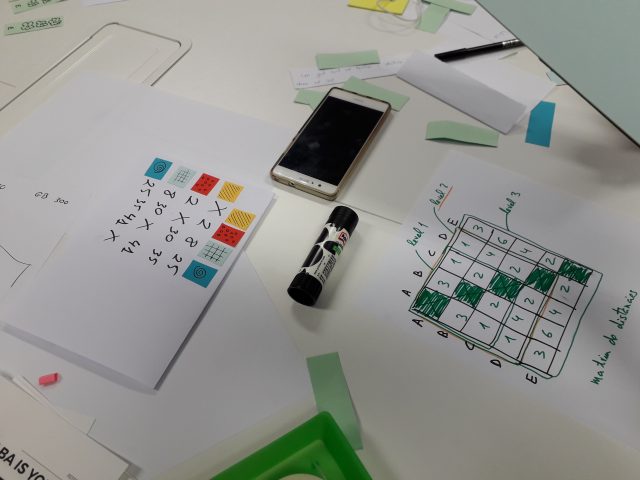GENIGMA aims to collaboratively investigate genomic alterations in cancer cells. The objective is to build, all together, a reference genomic map that allows scientists to understand which parts of the genome could play a fundamental role in the establishment and development of cancer.
Our project has been designed as a participatory process that involves citizens from the very beguinning, to incorporate the knowledge of people outside science and add value to the project.
These are the main concepts that we take from the cocreacions in which people with very different profiles and abilities participated (hence their great value!):
From the first co-creation with scientists, teachers and artists, we extracted three key points
1. the need to define a main challenge, based on the essence of the project
2. the importance of introducing the collaboration component between users, during the game
3. the value of using good metaphors to show the science behind, that we know complex and make clear to the player that they are using real data to do research.
From the second co-creation with patients and storytellers, we extracted two more points
4. The game has to happen in a fictional world but, at the same time, it must allow the player to connect with reality and provide mystery, adventure, surprise and knowledge.
5. To play conveys emotions: we must be able to get players to feel curiosity and intrigue, and also satisfaction, usefulness, pride, and feeling of belonging to a community.
Finally, from the third co-creation with professional players and game designers, we extracted three more points:
6. Science must be present in the game, but in a collateral side. The game mechanics will concern on order and disorder of pieces.
7. The emotions that a professional gamer wants to experience are not so different from no-gamers: in fact there are 5 that the two communities (gamers-no gamers) share. Satisfaction, curiosity, fun, challenge and belonging to a community.
8. The scientific problem is complex but can be transferred to the game using several elements that can be ordered on the screen and change in relation to the elements that are next to them.
In conclusion, we can say that due to participation of so many people with different visions, perspectives and knowledge, we were able to open our mind and incorporate new elements, which we had not thought of at first.
That is why we want to thank everyone who participated in this first phase of the project, for their time and valuable contributions!
Thanks to:
Ruggero Cortini, Roser Vilarrasa, Irene Farabella, Sandra Peiró, Jose Luis Villanueva, Sergi Betriu, Gemma Montalban, Núria Fusté, Quique Vergara, Coral Regí, Emma Bauer, Digna Couso, Nuria Jar, Lisa Johnsen, Anna Borrell, Maruxa Martínez, Carlos Sierra, Toni Hermoso, Oriol Valls, Marcel Cano, David Casadevall, Mike Goodstadt, Oriol Quadrada, Xavier Ramiro, Teresa Vidal, Lourdes Nicolich, Alexandros Nikolaou, Xavier Marti Renom, Marta Solis, Karel de Pourcq, Marc García, Toni López, Josep Serra, Marc Juan, Enric Miró, Eva, Marga Forn, Imma Cugat, Ruben Ventura, Melania Raccichini, Montserrat Prats, Mireia Ambròs, Olga Dolgova, Fernando Cruz, Heidy Baide, Pol Ezquerra, Daniel Moreno, Irene Lopez, Caritat Almazan, Montse Buisan, Mari Carme Sabater, Marc Figueras, Oscar Oliver, Gemma Artés, Isaac Hidalgo, Eira Melè, Alberto Moreno, Víktor Bautista, Martí Lucas, Lluisa Diaz, Dimas Alcalde, Jordi Serra, Oriol Bartumeu, Maria Perez, Marisol López, Marina Amores, David Xicota, Guillem Serra, Dani Cánovas, Fredi- Frederic Gil, Víctor Vieyra, Pau Tarés, Pauli Soler, Roger Olivella, Marc Angrill, Joan Serra.
-

-

-
 dav
dav -
